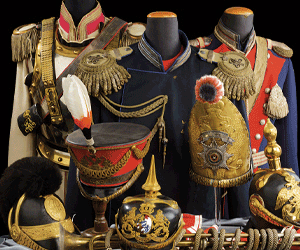Forestry 1929 Pattern Revierförster Shoulder Boards
SKU: 75.GOR.03.02.01.01.009
Estimated market value:

Estimated market value:
Attributes
History
Like every organisation during the Third Reich, forestry was placed under the control of the NSDAP. The Reichsforstamt (National Forestry Office) was created in 1934 to replace the regional forestry departments that had existed prior to this date. The goals of the Reichsforstamt were to extract economic value in the form of timber from the forests for the German industry, as well as preserve nature and natural monuments for the people as a part of German culture.
A sub-department for professional hunters employed by the government was created. Hunting matters had formerly been a part of the Ministry for Food and Agriculture, but were now placed under the influence of the Reichsforstamt.
Private forestry matters were placed under the care of the Reichsnährstand (National Nutritional Estate) in 1941.
The Reichsforstamt was headed by Luftwaffe leader Hermann Göring as Reichsforstmeister (minister of forestry).
The Reichsbund Deutsche Jägerschaft (National Society of German Hunters) was founded in 1934 as a statutory corporation for non-professional hunters. All existing hunting societies were disbanded and memberships transferred to the Deutsche Jägerschaft. Membership was mandatory for everyone with a hunting license.
Hermann Göring led the organisation as Reichsjägermeister (minister of hunting).
The Reichsforstschutz or Forstschutzkommando (Forestry Protection Service), in 1943 renamed to Forstschutzkorps (Forestry Protection Corps), was a paramilitary force instituted in February of 1940 in the General Government (occupied Poland). Made up of German forestry officials and ethnic Germans from Poland, the Forstschutz was tasked with regular forestry duties, as well as patrolling and protecting woodlands to keep them from being used by the Polish resistance. In 1942, Forstschutz personnel was also stationed in the Eastern European occupied territories where their work was heavily focused on anti-partisan operations.
Very little is known about the Forstschutz organisation today, and all items related to it are exceedingly rare.
The first pattern of Forestry shoulder boards worn after the NSDAP took power in 1933 was actually introduced in 1929 during the time of the Weimar Republic. This pattern was worn until early 1934. Since at this time no national forestry structure existed yet, each German state used its own system of forestry uniforms and insignia. The following 1929 pattern shoulder boards given as an example were worn in the State of Prussia. No information on the other German states was available at the time of writing.
The shoulder boards feature a dark green cloth backing and green cords, green and gold-coloured for higher ranks. Communal forestry personnel wore grey-green cords. For certain ranks, metal pips in the form of gold-coloured four-sided stars were used. The highest ranks used silver-coloured metal acorns instead.
The shoulder boards are as follows:
Oberlandforstmeister wore green/gold/green/gold/green cords braided to form four bends and a button loop, with three silver-coloured acorns.
Landforstmeister wore the same shoulder boards as the rank above, but with only two silver-coloured acorns.
Oberforstmeister wore the same shoulder boards as the rank above, but with three gold-coloured pips rather than two silver-coloured acorns.
Forsträte wore the same shoulder boards as the rank above, but with only two gold-coloured pips.
Forstmeister (also referred to as Oberförster) wore the same shoulder boards as the rank above, but with only one gold-coloured pip.
Forstassessoren wore the same shoulder boards as the rank above, but without any gold-coloured pips.
Forstreferendare wore two double-laid and one single-laid parallel green/gold/green triple-cords.
Forstverwalter wore two green double-cords braided to form four bends and a button loop, on a secondary gold-coloured backing and with a gold-coloured pip.
Revierförster wore the same shoulder boards as the rank above, but without any pips.
Förster wore two green double-cords braided to form four bends and a button loop, and one gold-coloured pip.
Hilfsförster wore the same shoulder boards as the rank above, but without any pips.
Forstgehilfen wore five green double-laid parallel cords.
Unterförster wore three green double-laid parallel cords.


Comments
Sign in to comment and reply.


Scroll Top